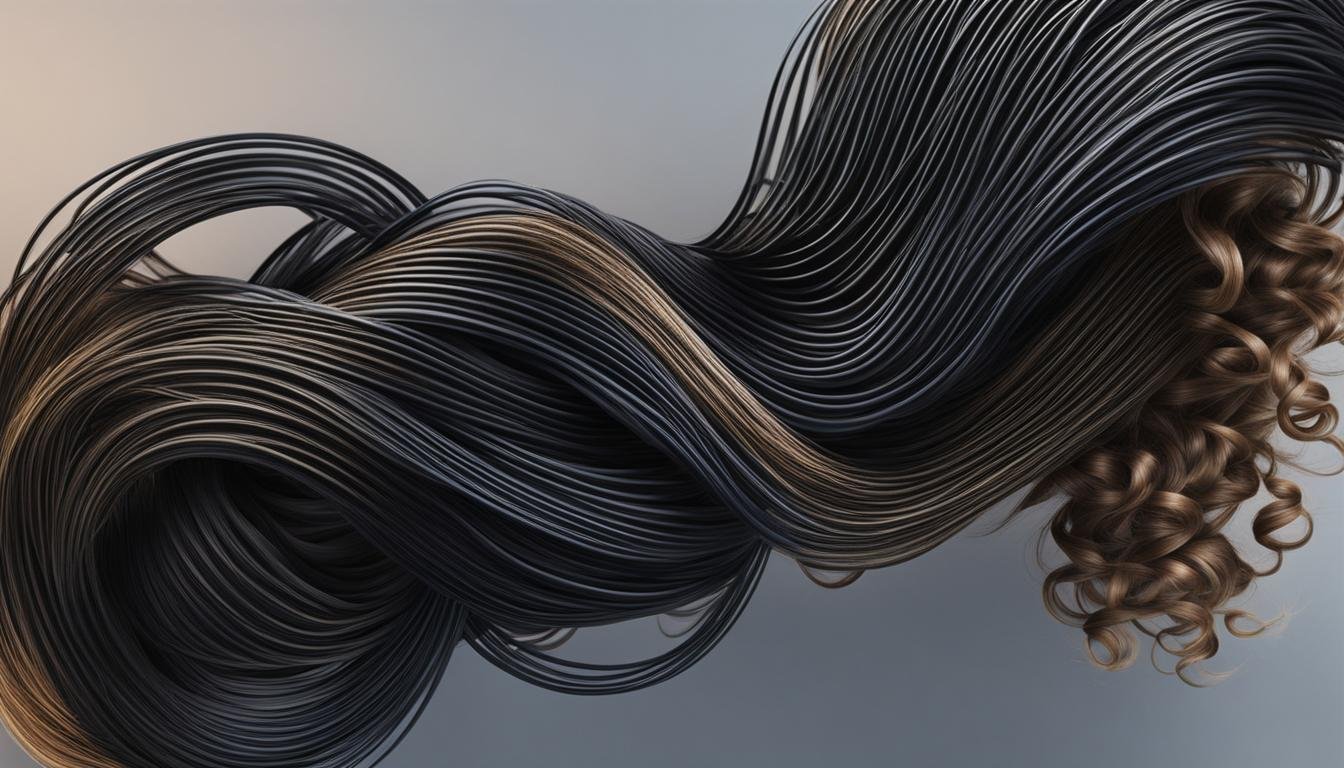Have you ever noticed that your hair stretches like a rubber band? While it may seem fascinating, it is actually an indication that your hair may not be as healthy as it appears. This article will explore the phenomenon of hair elasticity, commonly known as “rubber band hair,” and provide tips on how to care for your hair to maintain its health and prevent damage.
Excessive hair elasticity, or stretchiness, is often caused by factors such as overprocessing, chemical treatments, and excessive heat. These practices can damage the hair’s structure and hinder its ability to retain moisture, leading to dryness, brittleness, and breakage.
Understanding the concept of hair elasticity is crucial in recognizing the signs of damage. Hair elasticity refers to the hair’s ability to stretch and return to its original state. Healthy hair retains moisture in the cortex, the inner layer of the hair, giving it bounce and flexibility. Damaged hair, on the other hand, struggles to retain moisture, resulting in dryness and breakage.
Various factors can contribute to stretchy hair. Overprocessing, chemical treatments like bleaching or perming, and excessive heat styling can all lead to hair damage and reduce its elasticity. Dryness and brittleness are common symptoms of stretchy hair, indicating a need for extra care and attention.
To determine the elasticity of your hair, you can perform a simple hair elasticity test. Wet a small section of hair, hold it at the root, and gently stretch it mid-length. Healthy hair will bounce back to its original state, while damaged hair may take longer to bounce back or even snap off. This simple test can help identify if your hair needs assistance in regaining its strength and elasticity.
Restoring hair elasticity requires a comprehensive approach. Repairing products like the Olaplex Repairing Kit can help rebuild the hair’s structure and improve its strength. Using a heat protectant spray can reduce further damage from heat styling, while finding the right balance between protein and moisture is crucial for hair health. Additionally, minimizing heat damage and considering temporary solutions like clip-in or tape-in hair extensions can help while waiting for natural hair to regain its strength and elasticity.
Maintaining hair elasticity is essential to ensure its long-term health. Establishing a proper hair routine that includes protein treatments, moisture treatments, and personalized care based on your hair type and elasticity level can contribute to maintaining optimal hair health. By consistently providing the necessary care and attention, you can enjoy strong, resilient, and vibrant hair without the “rubber band” effect.
Understanding Hair Elasticity
Hair elasticity refers to the ability of hair to stretch and return to its original state. It is a crucial aspect of hair health and can provide valuable insights into the overall condition of your hair.
The elasticity of hair is directly influenced by its structure and moisture retention. To understand this concept better, let’s dive into the details.
Hair Structure
The structure of your hair plays a significant role in determining its elasticity. Each strand of hair consists of multiple layers, with the cortex being the innermost layer. It is within the cortex that the magic of hair elasticity happens.
The cortex contains proteins called keratin, which give hair its strength and structure. Additionally, it also stores moisture that helps maintain the hair’s flexibility and resilience.
Moisture Retention
Healthy hair retains moisture effectively, allowing it to stretch and bounce back without damage. The moisture in the cortex provides hydration, giving your hair its natural shine and elasticity.
However, damaged hair tends to struggle with moisture retention. External factors such as overprocessing, excessive heat styling, and chemical treatments can disrupt the hair’s structure, leading to difficulties in retaining moisture.
Dryness, Brittleness, and Breakage
When hair lacks proper moisture retention, it becomes dry, brittle, and prone to breakage. Dryness makes hair more susceptible to damage, leading to decreased elasticity and increased hair breakage.
To summarize, understanding hair elasticity requires knowledge of the hair’s structure and its moisture retention capabilities. Healthy, well-moisturized hair retains its elasticity, while dry and damaged hair struggles to bounce back, resulting in brittleness and breakage.
Causes of Stretchy Hair
Stretchy hair, characterized by its rubber band-like texture, is often a result of various factors that damage the hair’s structure and impede its ability to retain moisture. The most common causes of stretchy hair include overprocessing, chemical treatments, and excessive heat styling.
Overprocessing, such as frequent use of hair dyes and perms, can cause significant damage to the hair. These processes involve the use of harsh chemicals that strip the hair of its natural moisture and disrupt the protein structure within the hair shaft. As a result, the hair becomes weak, lacking elasticity, and prone to stretching and breakage.
Chemical treatments, including bleaching, perming, and relaxing, can also contribute to stretchy hair. These treatments alter the hair’s internal structure, breaking down the protein bonds that give it strength and elasticity. The use of strong chemical solutions and excessive processing times can further exacerbate the damage, leading to dryness, brittleness, and increased hair stretchiness.
Excessive heat styling, such as frequent use of flat irons, curling wands, and blow dryers, can cause heat damage to the hair. The high temperatures used in these styling tools can deplete the hair’s moisture content and weaken its structure. Prolonged and frequent exposure to heat can cause the hair to become dry, brittle, and elastic, making it easily prone to stretching and breakage.
To maintain healthy hair and prevent stretchiness, it’s important to minimize overprocessing, avoid excessive chemical treatments, and protect the hair from excessive heat styling. Additionally, incorporating a moisturizing hair care routine, using heat protectant products, and seeking professional advice can help restore the hair’s elasticity and overall health.
How to Check Hair Elasticity
If you’re concerned about the elasticity of your hair, there’s a simple hair elasticity test you can perform. This test can help you determine the current state of your hair’s strength and flexibility. By understanding your hair’s elasticity, you can make informed decisions about its care and treatment.
To conduct the hair elasticity test, follow these steps:
- Wet a small section of your hair. This can be done by spritzing it with water or running it under a faucet. Wetting the hair ensures that it is in its most flexible state.
- Hold the wet section of hair at the root between your fingers.
- Gently stretch the hair mid-length and release.
Here’s what to look for during the hair elasticity test:
If your hair is healthy, it will bounce back to its original state after being stretched. This means that it has good elasticity and can withstand stretching without breaking. On the other hand, damaged and unhealthy hair may take longer to bounce back or even snap off during the test.
Performing the hair elasticity test regularly can help you monitor the condition of your hair and identify any issues that require attention. If your hair fails the test and lacks bounce back, it could be a sign of breakage or damage.
Remember, hair elasticity is essential for maintaining healthy and resilient hair. If you find that your hair is lacking in elasticity, there are several steps you can take to restore it. These steps often include incorporating proper hair care techniques, using appropriate products, and seeking professional advice.
Common Hair Elasticity Test Results and Interpretations
| Result | Interpretation |
|---|---|
| Bounces back quickly to original state | Healthy hair with good elasticity |
| Takes longer to bounce back or snaps off | Damaged or unhealthy hair with reduced elasticity |

Performing the hair elasticity test and understanding the results can guide you in your journey to maintaining and improving the health of your hair. By addressing underlying issues, you can help your hair regain its natural strength and elasticity, reducing breakage and promoting overall hair health.
Restoring Hair Elasticity
In order to restore hair elasticity, it’s important to incorporate the right products and practices into your hair care routine. By focusing on repairing the hair’s structure, protecting it from heat damage, and maintaining a proper protein-moisture balance, you can help rejuvenate your hair and bring back its natural elasticity.
- Repairing Products: Using hair repair products, such as the Olaplex Repairing Kit, can be highly beneficial in rebuilding the hair’s structure and improving its overall strength. These products are specifically formulated to target and repair damaged hair, helping restore elasticity and vitality.
- Heat Protectant Spray: Protecting your hair from excessive heat is crucial in reducing further damage. Incorporating a heat protectant spray into your styling routine forms a protective barrier between your hair and heat styling tools, minimizing the impact of high temperatures and helping to preserve your hair’s elasticity.
- Protein-Moisture Balance: Maintaining the proper balance between protein and moisture is essential for hair health and elasticity. While proteins strengthen the hair, excessive protein use without adequate moisture can lead to dryness and brittleness. Ensuring your hair receives the right amount of protein and moisture is key in promoting elasticity and preventing damage.
- Reducing Heat Damage: Limiting the use of heat styling tools, such as flat irons and curling wands, can significantly reduce heat damage and improve hair elasticity. When heat styling is necessary, using lower heat settings and applying a heat protectant spray can help minimize the negative effects on your hair.
To visually illustrate the importance of repairing products, here is an image showcasing a popular hair repair kit:
By incorporating these practices and products into your hair care routine, you can effectively restore your hair’s elasticity and promote long-term hair health.
Additional Tips for Hair Elasticity
If you’re looking for additional ways to enhance your hair’s elasticity and improve its overall health, there are a few options you can consider. These solutions can help you cope with damaged hair while waiting for it to regain its natural strength and bounce.
1. Hair Extensions
One popular option to temporarily add volume and bounce to damaged hair is using hair extensions. Whether you opt for clip-in hair extensions or tape-in hair extensions, they can provide instant length and volume while protecting your natural hair from further damage.
2. Regular Haircuts
To maintain healthy hair and remove severely damaged portions, regular haircuts are essential. Trimming your hair regularly helps prevent split ends from traveling up the hair shaft and causing more damage. Consult with a professional hairstylist to determine the frequency and length of your haircuts based on your hair type and condition.
3. Solutions for Damaged Hair
When it comes to damaged hair, there are various solutions available in the market. You can explore products specifically designed to repair and restore damaged hair, such as deep conditioning masks, leave-in treatments, and serums. Look for products that contain nourishing ingredients like argan oil, keratin, and vitamins to help replenish moisture and strengthen your hair.
“Damaged hair requires special attention and care. Investing in high-quality hair care products and following a consistent routine can help restore your hair’s elasticity and vitality.”
– Expert Hairstylist
Maintain Hair Elasticity
Keeping your hair elastic and healthy requires a consistent and personalized hair care routine. By incorporating protein treatments and moisture treatments into your regimen, you can effectively balance the protein-moisture ratio in your hair, promoting elasticity and overall hair health.
Protein treatments, such as the Repair Treatment, help strengthen and repair damaged hair, restoring its natural elasticity. These treatments replenish the protein lost due to factors like chemical treatments and heat styling, improving the structural integrity of your hair.
Moisture treatments, like the Moisture Treatment, nourish the hair with hydration, combating dryness and promoting elasticity. By infusing your hair with the right amount of moisture, you can prevent brittleness and breakage, keeping your hair flexible and bouncy.
To develop a personalized hair care routine that suits your individual needs, consider your hair type and elasticity level. Consult a professional stylist or hair care expert who can guide you in selecting the appropriate products and techniques to maintain optimal hair elasticity and health.
